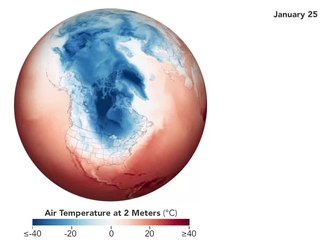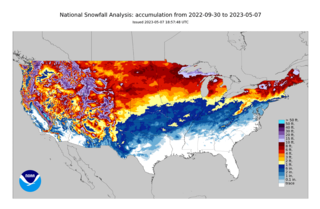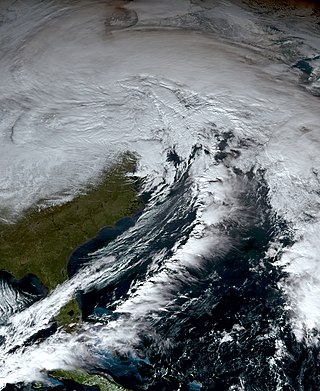Related Research Articles

The blizzard of 1977 hit Western New York and Southern Ontario from January 28 to February 1. Daily peak wind gusts ranging from 46 to 69 mph were recorded by the National Weather Service in Buffalo, with snowfall as high as 100 in (254 cm) recorded in areas, and the high winds blew this into drifts of 30 to 40 ft. There were 23 total storm-related deaths in Western New York, with five more in northern New York.

In meteorology, a heat burst is a rare atmospheric phenomenon characterized by a sudden, localized increase in air temperature near the Earth's surface. Heat bursts typically occur during night-time and are associated with decaying thunderstorms. They are also characterized by extremely dry air and are sometimes associated with very strong, even damaging, winds.

This article describes severe weather terminology used by the National Weather Service (NWS) in the United States. The NWS, a government agency operating as an arm of the National Oceanic and Atmospheric Administration (NOAA) branch of the United States Department of Commerce (DoC), defines precise meanings for nearly all of its weather terms.

The October 2006 Buffalo storm was an unusual early-season lake effect snow storm that hit the Buffalo, New York area and other surrounding areas of the United States and Canada, from the afternoon of Thursday, October 12 through the morning of Friday, October 13, 2006. It was called Lake Storm Aphid by the National Weather Service office in Buffalo, in accordance with their naming scheme for lake-effect snowstorms for that year, which related to insects, though locals never used that terminology and have simply referred to it as the October Surprise or the October Storm or Arborgeddon.

This article describes severe weather terminology used by the Meteorological Service of Canada, a branch within Environment and Climate Change Canada. The article primarily describes various weather warnings, and their criteria. Related weather scales and general weather terms are also addressed in this article. Some terms are specific to certain regions.
A particularly dangerous situation (PDS) tag is enhanced wording first used by the Storm Prediction Center (SPC), a national guidance center of the United States National Weather Service, for tornado watches and eventually expanded to use for other severe weather watches and warnings by local NWS forecast offices. It is issued at the discretion of the forecaster composing the watch or warning and implies that there is an enhanced risk of very severe and life-threatening weather, usually a major tornado outbreak or a long-lived, extreme derecho event, but possibly another weather hazard such as an exceptional flash flood or wildfire.

Global storm activity of 2008 profiles the major worldwide storms, including blizzards, ice storms, and other winter events, from January 1, 2008 to December 31, 2008. A winter storm is an event in which the dominant varieties of precipitation are forms that only occur at cold temperatures, such as snow or sleet, or a rainstorm where ground temperatures are cold enough to allow ice to form. It may be marked by strong wind, thunder and lightning, heavy precipitation, such as ice, or wind transporting some substance through the atmosphere. Major dust storms, Hurricanes, cyclones, tornados, gales, flooding and rainstorms are also caused by such phenomena to a lesser or greater existent.
Global weather activity of 2007 profiles the major worldwide weather events, including blizzards, ice storms, tornadoes, tropical cyclones, and other weather events, from January 1, 2007, to December 31, 2007. Winter storms are events in which the dominant varieties of precipitation are forms that only occur at cold temperatures, such as snow or sleet, or a rainstorm where ground temperatures are cold enough to allow ice to form. It may be marked by strong wind, thunder and lightning, heavy precipitation, such as ice, or wind transporting some substance through the atmosphere. Other major non winter events such as large dust storms, Hurricanes, cyclones, tornados, gales, flooding and rainstorms are also caused by such phenomena to a lesser or greater existent.
A wind chill advisory is a hazardous weather statement issued by Weather Forecast Offices (WFO) of the National Weather Service (NWS) in the United States to alert the public that wind chills are forecast to reach values low enough that it poses a threat to human health and life if adequate protection is not taken against hypothermia and frostbite. The exact criteria meriting the issuance of an advisory varies from state to state, and areas prone to colder temperatures will often require the wind chill to be lower before issuing an advisory.
A wind chill watch is issued by the National Weather Service of the United States when the wind chill could reach dangerous levels within the next 12 to 48 hours. The exact definition required to issue a watch varies from state to state or from National Weather Service county warning areas to another, but if forecasters believe conditions are favorable for life-threatening wind chills meeting local criteria, a watch will be issued. People going outside should plan to protect themselves against hypothermia and frostbite.
A wind chill warning is a hazardous weather statement issued by local forecast offices of the National Weather Service (NWS) in the United States and previously by the Meteorological Service of Environment and Climate Change Canada (ECCC) when wind chills are forecast to reach values low enough for residents and travelers to be susceptible to life-threatening medical conditions or death associated with accelerated body heat loss.

The 1994 North American cold wave occurred over the midwestern and eastern regions of the United States and southern Canada in January 1994, which caused over 100 deaths in the United States alone. Two notable cold air events took place from January 18–19 and January 21–22. There were 67 minimum temperature records set on January 19. Indiana and Kentucky both set state records on January 19. During this time, the United States experienced its coldest temperatures since February 1934, although much of the West experienced mild temperatures. While Washington and Idaho experienced the second-warmest January recorded in the previous 100 years, the eastern United States experienced a major snowfall, which significantly delayed traffic.

The early 2014 North American cold wave was an extreme weather event that extended through the late winter months of the 2013–2014 winter season, and was also part of an unusually cold winter affecting parts of Canada and parts of the north-central and northeastern United States. The event occurred in early 2014 and was caused by a southward shift of the North Polar Vortex. Record-low temperatures also extended well into March.

The 2015–16 North American winter was not as frigid across North America and the United States as compared to the 2013–14 and 2014–15 winters. This was mainly due to a strong El Niño, which caused generally warmer-then-average conditions. However, despite the warmth, significant weather systems still occurred, including a snowstorm and flash flooding in Texas at the end of December and a large tornado outbreak at the end of February. The main event of the winter season, by far and large, was when a crippling and historic blizzard struck the Northeastern United States in late January, dumping up to 3 feet of snow in and around the metropolitan areas. Several other smaller snow events affected the Northeast as well, but for the most part the heaviest snowstorms and ice stayed out further west, such as a severe blizzard in western Texas in late December, and a major late-season snowstorm in Colorado in mid-April.

In late January 2019, a severe cold wave caused by a weakened jet stream around the Arctic polar vortex hit the Midwestern United States and Eastern Canada, killing at least 22 people. It came after a winter storm brought up to 13 inches (33 cm) of snow in some regions from January 27–29, and brought the coldest temperatures in over 20 years to most locations in the affected region, including some all-time record lows. In early February, a concentration of Arctic air colloquially referred to as the "polar vortex" moved west, and became locked over Western Canada and the Western United States. As a result, February 2019 was among the coldest and snowiest on record in these regions. In early March, the cold once again shifted east, breaking records in many areas. In mid-March, the cold wave finally retreated, but combined with above-average temperatures, precipitation, and a deep snowpack, widespread flooding ensued in the Central US.

The 2019–20 North American winter was unusually warm for many parts of the United States; in many areas, neutral ENSO conditions controlled the weather patterns, resulting in the sixth-warmest winter on record, and many areas in the Northeastern United States saw one of the least snowy winters in years. In fact, Baltimore and Islip saw no snow in February for the first time. Some notable events still occurred, such as a powerful blizzard that impacted the Western United States in late November, a series of cold shots in January and February, a snowstorm within the Texas Panhandle and a late-season blizzard in the High Plains.

The 2020–21 North American winter was the most significant winter season to affect North America in several years, and the costliest on record, with a damage total of at least $33.35 billion. The season featured 6 storms ranking on the Regional Snowfall Index scale, with 4 storms ranking as at least a Category 3. Most of the winter's damage and fatalities occurred due to a historic and major cold wave in mid-February. Several other significant events occurred, including a crippling early-season ice storm in the Southern Plains, a powerful nor'easter in mid-December, another major nor'easter in early February, two major and widespread winter storms in mid-February, and a major blizzard in the Rocky Mountains in mid-March. The winter-related events were responsible for at least 358 fatalities, making it the deadliest season since 1992–93. A La Niña pattern influenced much of the winter in North America.

The 2021–22 North American winter was not as significant and record-breaking as the previous winter season. Despite this, several notable and significant events still occurred, including two separate record-breaking tornado outbreaks in mid-December, a significant winter storm in the South in mid-January, a powerful blizzard that impacted the Northeast coast at the end of January and a wide-ranging, significant winter storm that affected most of the eastern half of the country in early February. Additional significant events included a late-season winter storm in March that affected the Appalachian Mountains, and a major blizzard that affected North and South Dakota in mid-April. Addiitonally, a very late out-of-season snowstorm struck the Rocky Mountains in late May. During the season, four storms have been ranked on the Regional Snowfall Index (RSI), although none attained the “Major” category. Similar to the previous winter, a developing La Niña was expected to influence weather patterns across the continent.

The 2022–23 North American winter is the ongoing winter in North America, as it will occur across the continent from late 2022 to early 2023. The winter season in North America began at the winter solstice, which occurred on December 21, 2022, and it will end at the March equinox, which will occur on March 20, 2023. The first day of meteorological winter began on December 1 and will unofficially end on February 28; winter storms may still occur outside of these limits.

From December 21 to 26, 2022, a historic extratropical cyclone created winter storm conditions, including blizzards, high winds, snowfall, or record cold temperatures across the majority of the United States and parts of Canada. Areas which experienced blizzard conditions included parts of Minnesota, Iowa, Wisconsin, Michigan, Ohio, New York and Ontario, with the Buffalo area of New York and the Fort Erie and Kingston areas of Ontario experiencing almost two full days of blizzard/zero-visibility conditions on December 23 and 24. The cold wave affected all U.S. states from Colorado to the eastern seaboard and as far south as Miami, Florida. On December 24, 110 million people across 36 states were subject to wind chill alerts.
References
- ↑ Environment Canada. "Wind Chill Hazzards". Archived from the original on December 17, 2005.
- 1 2 Extreme Cold Warning
- ↑ "National Weather Service Plans to Issue 'Extreme Cold Warnings'". Archived from the original on 2013-06-16.
- ↑ "NWS To Experiment With 'Extreme Cold' Warnings". 10 January 2011.
- ↑ "Experimental Cold Warning Feedback Needed".
- ↑ "NWS Tests Extreme Cold Warning". Archived from the original on 2013-06-09.
- ↑ "National Weather Service ditching 'extreme cold' warnings".
- ↑ "National Weather Service Public Information Statement PNS18-11" (PDF). Retrieved February 1, 2019.
- ↑ "Update on Winter Weather Initiatives Partner Webinar" (PDF). Retrieved February 1, 2019.